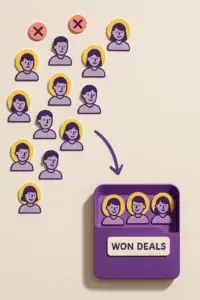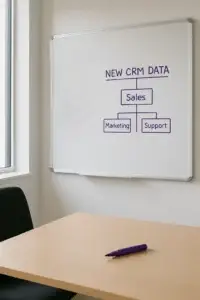It’s a busy world we live in, for both you and your prospects. Your contact with them is one small part of a day that is full of plenty of other things to do. So, in order to make an impression that lasts, you have to keep making that impression.
The first part is having enough of a presence to make someone want to come back. This, of course, is through many things, chiefly branding. Making your company stand out amongst the crowd will raises the possibility of prospects returning to inspect your company and its products/services multiple times before deciding to buy.
The second part is less passive, and requires you building on the foundations of interactions you’ve already started to make with a prospect. Yes—these are follow ups. Especially if you don’t have a tool to automate the process, this can get lost in the day-to-day running of your business. It’s an easy mistake to make, but they are crucial to your sales process: 80% of your sales need, on average, 5 follow ups to finally close the sale. You need to prove to a prospect that your business is the only option, every time.
So if this is a problem you’ve been facing, how do you reduce the likelihood of forgetting to follow up on a prospect?
Recording Follow Ups: Time is of the Essence
Especially if you’re having sales calls or meeting possible clients, you’re likely to be amassing a significant amount of information about them. Whether it’s in one go, or a drip feed of knowledge, this can accumulate to build up a detailed picture of who your prospect is.
But information isn’t just details about their life, work or business. It’s also about timing. Things like deadlines, availability, can be mentioned, for example, in conversations, which shapes your marketing for them going forward. Yet it’s also about when they’re active. This also shapes your marketing for them, because once you gather this data you can use it to target your prospect at exactly when they’re most receptive to it. If you know the best times they’re going to be free to hear from you, you can slot in follow ups that way, and keep them interested.
You might also agree on a time to follow up (‘come back to me in the next 3 months’, for example) whilst you’re in contact. It’s simple, but effective: as soon as you hear it, or as soon as you finish the call—note it down/and set a reminder. The act of noting something down can solidify it as an event in your mind, meaning you’re less likely to forget. There is also the obvious benefit of being able to find and look back on your notes if you can’t remember everything from the conversation.
Understand Your Prospect’s Sales Journey
How much you need to make follow ups, and their frequency, is unique to your prospect’s sales journey; it won’t be the same for every business. It therefore stands to reason that being aware of your prospect’s sales journey will help you become more aware of what holes you still need to jump through. This includes when you need to think about follow ups!
Getting familiar with the prospect sales journey will help you understand your prospect’s behaviour across the whole thing; this means you can react, and target, in a more accurate fashion. Your prospect will be more receptive, because you’re ticking all the right boxes at the right time.
For your follow ups, you’ll be able to gauge whereabouts your prospect is on their sales journey, and what steps are needed to progress them to the next stage. Knowing when follow ups will be needed can become almost intuitive, especially when backed up by previous experience.

Expecting Follow Ups: Remind Yourself Regularly
One of the best ways to not forget follow ups is by establishing habits that prevent it happening in the first place. Like noting down any upcoming events, making yourself act on the reminder can be one of the best preventative measures—as deliberately making yourself complete a task can mark it as ‘important’ in your head, and thus make it easier to remember. We talk more about training your brain here.
Establish a habit of checking up on your prospects and the information you’ve collected over time. If it indicates 1) positive signs that they’d be receptive to contact; and 2) enough time between last contact, then you should be coming up to contacting them again. Of course, there’s nothing better than a direct organised event to show you when next to chat.
Your prospects will be on unique timelines, so it makes sense to establish this as a frequent task—how frequent is up to you. But establishing this as a regular habit will keep you on top of your prospect’s progress, and make you more attentive to their needs as a result. The more on it you are, the more likely you are to get a sale!
Use Your Measuring
Your previous experience will be a great asset in figuring out when you should be next following up with your prospects. Your responses will show how long you typically take between points of contact, and which ones have been successful. If this is something you don’t have to hand, compiling reports from your prospects this way will give you fantastic insights moving forward, and help you assemble a coordinated response to your prospects in the future.
Record Follow Ups in a CRM
The best solution is finding a tool that makes sure you never forget, by reminding you when it’s time for a follow up. For businesses, a CRM can make this happen for you, whether manually or automatically.
A CRM like popcorn combines all the above tactics into one place. Your CRM can store and accumulate all the information you have on a prospect, including any notes you take during a conversation. (In popcorn, this is accessible by a one-click popup of the contact’s profile!) You can also set up reminders so, whatever you do, you’ll be reminded of needing to follow up regardless. And, finally, your CRM can help you visualise your customer’s sales journey—in popcorn’s case, for example, by displaying it in sales pipelines. This is the customer journey writ large: you can see when you last contacted them, and what stage they’re in. As this will also be part of the bigger picture, you can coordinate your prospects into campaigns too.
With automation, you can set up reminders to follow up in response to a prospect’s activity, so you can always stay on top of your contact’s behaviour and nurture them to become a customer.
Interested in how popcorn can help you coordinate your prospecting? Find out more by clicking here.
Enjoyed this post? Comment below or read through our blog for more lead management and CRM tips, especially for small businesses.











